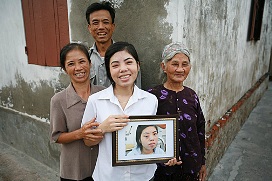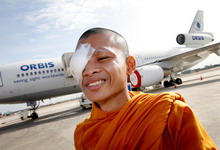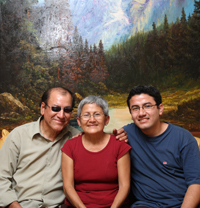Orbis International: Eye Doctors Wing it to Volunteer in Developing Countries
Look, up in the sky, it's an eye hospital on a DC-10 airplane!
Its mission: to fly to poor parts of the world where eye care is desperately needed.
More Than Your Average Plane

The airplane, operated by Orbis International, is used for more than sending eye doctors out to perform cataract removals and other surgeries, according to Canadian ophthalmologist Brian Leonard, MD. He is past chair of ophthalmology at the University of Ottawa, and he is one of many ophthalmologists and related health care professionals who go on missions to help save people's sight. He is currently president of the board of directors for Orbis Canada, and he is the founding director of the University of Ottawa Eye Institute.
Orbis is a non-profit organization whose purpose is to eliminate avoidable blindness in developing countries. It does this by providing training for local ophthalmologists and related providers. The people who volunteer teach skills that work within the local systems to treat potentially blinding conditions. The organization got its start in the 1970s and was the brainchild of Dr. David Paton, an ophthalmologist from the Baylor College of Medicine in Texas.

Dr. Leonard has provided extensive training through Orbis in many parts of the world, including Africa, China, and Vietnam. He is also a pilot and was literally behind the wheel for a number of missions. He first became involved with Orbis in the early 1980s, and he piloted the plane that was used back then, a DC-8.
"I've done 52 programs with this airplane in developing countries worldwide," Dr. Leonard said at a 2006 meeting of the Canadian Ophthalmological Society. The plane was replaced a decade ago with a DC-10. Sadly, Dr. Leonard cannot fly the newer plane, but he still continues to perform surgery and provide training.
The Orbis plane is impressive. It contains a 52-seat classroom, audiovisual room, examination room, laser treatment room, patient recovery area, office, and conference center.
Ophthamologists, faculty, and pilots who go on missions do so as volunteers, but nurses and the anesthetist are salaried. University-affiliated faculty fly out to wherever the Orbis plane happens to be. They stay for two or three weeks at the site, teaching and seeing patients.
Increasing Local Clinical Knowledge

Background work is done in the community first, before the Orbis plane is sent on a mission. Crews generally visit a location up to four times "to catalogue and inventory the infrastructure and existing conditions," Dr. Leonard said. "The goal isn't to go in and show off high-tech western medicine."
Host doctors, the local ministry of health, hospitals, and the area's university are all brought in to help Orbis organizers determine what type of program will best benefit a community, and what training can be used in their existing local facilities.
"We study the infrastructure and design with them in a three-week program, then pick the visiting faculty according to that," Dr. Leonard said.
Once at a site, the Orbis team goes into the local hospital with their host doctors. "We examine patients that they've seen in advance, teaching as we go, and select from these the patients that we will operate on with the host doctors on the airplane, or in their local hospitals," he said.
Teaching can include everything from surgical and anesthetic techniques to creating a sterile environment and improving bedside manner -- whatever is needed and appropriate to the setting. Using audiovisual technology, surgeries that are performed on the plane are broadcast to people sitting in the plane's classroom, and sometimes to medical and nursing audiences outside the plane.
Beyond the Runway

About 85% of Orbis activities are hospital-based, and volunteers go to many areas without the airplane. Additional programs -- what Orbis refers to as "capacity building" -- can include training related to technical assistance, how to educate communities, or changing institutional procedures (such as improving efficiency). A number of these capacity-building projects are long-term, lasting at least three years. The volunteers work with a variety of health partners, including hospitals, government health departments, universities, and local non-governmental organizations.
Another teaching aspect of Orbis relates to telemedicine and a website. The website offers an e-library with educational material, as well as a section where ophthalmologists in developing countries can consult online with Orbis tutors with whom they've been matched.
The needs of each Orbis program varies, according to local needs and culture. Not everyone welcomes outsiders in the same way.
For those interested in working in this field, there are a number of other volunteer agencies that help get medical eyecare to disparate parts of the world. Among these are include Medical Ministry International, Unite for Sight, and the American Academy of Ophthalmology EyeCare America program.
About the Author
Pippa Wysong is an award-winning science and medical writer who writes for diverse audiences ranging from specialty physicians to 8-year-old kids. She writes for daily newspapers, popular magazines, specialty medical publications and websites. Her stories appear in The Globe & Mail, The Medical Post, Weekly Reader magazines, Canadian Living, and Medscape/WebMD. For children, she wrote the "Ask Pippa" Q&A science column in the Toronto Star from 1988-2008. She can be reached through LinkedIn or through her Ask Pippa website.
About Angels in Medicine
Angels in Medicine is a volunteer site dedicated to the humanitarians, heroes, angels, and bodhisattvas of medicine. The site features physicians, nurses, physician assistants and other healthcare workers and volunteers who reach people without the resources or opportunities for quality care, such as teens, the poor, the incarcerated, the elderly, or those living in poor or war-torn regions. Read their stories at www.medangel.org.